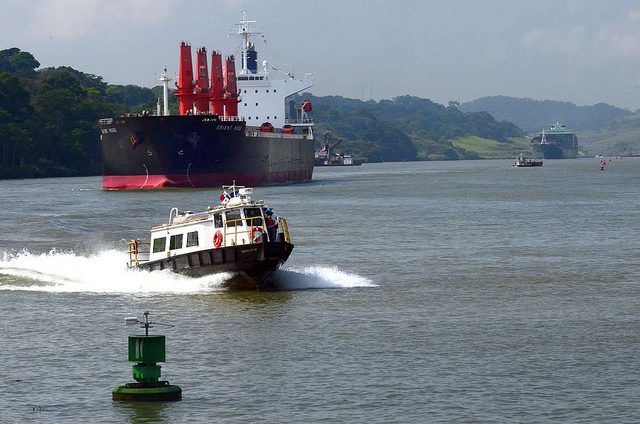Ships transit the Panama Canal. Photo (c) Canal de Panamá.

By Ivan Castro
MANAGUA, June 13 (Reuters) – Nicaraguan lawmakers granted a 50-year concession to a Chinese company on Thursday for it to design, build and manage a shipping channel across the Central American nation that would compete with the Panama Canal.
The $40 billion proposal by HK Nicaragua Canal Development Investment Co Ltd’s (HKND Group) calls for linking Nicaragua’s Caribbean and Pacific coasts and includes plans for two free-trade zones, a railway, an oil pipeline and airports.
SEE ALSO: Nicaragua Canal – Developer FAQ and Interview
The government says the canal, which has been discussed for decades, could boost the country’s gross domestic product by up to 15 percent.
“Today is a day of hope for the poor of this country,” said Edwin Castro, a lawmaker in President Daniel Ortega’s ruling party, before the vote marking final legislative approval of the deal.
The Hong Kong-based HKND group is headed by Chinese lawyer Wang Jing. He also leads Chinese company Xinwei Telecom Enterprise Group, which last year received a cellphone concession in Nicaragua.
“Central America is at the center of North-South and East-West global trade flows, and we believe Nicaragua provides the perfect location for a new international shipping and logistics hub,” Jing said in a statement after the plan’s approval.
“We have a lot of work ahead, but we want to be clear that we intend this to be a world-class effort that creates economic opportunity, serves the global trade community, and also protects the local environment, heritage, and culture of Nicaragua.”
Critics of the plan have railed against selling out state assets to the Chinese. After Thursday’s vote, a group of opposition lawmakers left the chamber singing Nicaragua’s national anthem before unfurling a banner that read, “Ortega: traitor.”
About 100 people gathered outside the assembly to protest the decision, but there were no reported incidents.
TIMING RIGHT?
Last week Ortega said the government was going ahead with feasibility studies that should be done by 2015, when work on the canal could begin.
Those studies will define what route the canal will cut through the country. Any design would almost certainly bisect Lake Nicaragua, which at 3,191 square miles (8,265 sq km) is Central America’s largest lake.
Advocates say the proposal plays to Nicaragua’s natural strengths, which include low-lying land and the lake.
Still, the channel would likely be three times longer than the 48-mile (77-km) Panama Canal, which took the United States a decade to build at the narrowest part of the isthmus. It was completed in 1914.
The idea of a Nicaraguan shipping canal is almost as old as the country itself. The United States has eyed a trade route there since the 19th century, around the same time work began on the Panama Canal.
But for the project’s Chinese backers, the timing appears right. China is the world’s second-largest economy and one of the region’s top consumers, snapping up Latin American commodities to drive domestic growth.
“We believe that by 2030 – just over 16 years from now – the volume of trade addressable by the Nicaragua Canal will have grown by 240 percent from today,” the company said in a statement.
“The total value of goods transiting the combined Nicaragua and Panama canals could exceed $1.4 trillion, making this one of the most important trade routes in the world,” it said.
Panama Canal officials said it was too early to speculate on the viability of the Nicaraguan waterway or how it could affect trade.
“We get questions of hypotheticals every day, ‘What happens if the Arctic melts, if manufacturing is moved from China to Mexico,'” said Rodolfo Sabonge, vice president of market research at the Panama Canal Authority.
“Until we really see the plans and understand the investment, all we know is that they talk about $40 billion,” he said. “It’s very, very early.” (Reporting by Ivan Castro; Additional reporting by Lomi Kriel in Panama City; Writing by Gabriel Stargardter; Editing by Simon Gardner and Xavier Briand)
(c) 2013 Thomson Reuters, Click For Restrictions

 Join The Club
Join The Club











